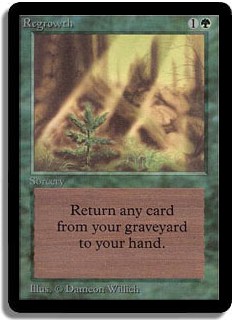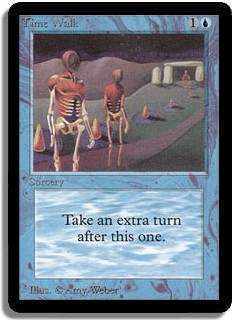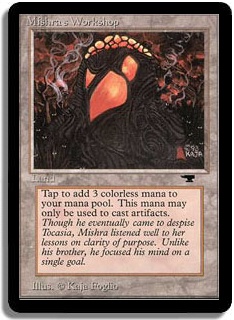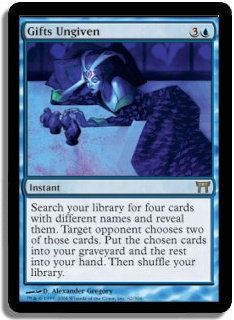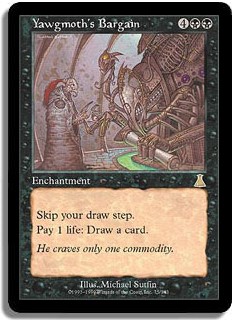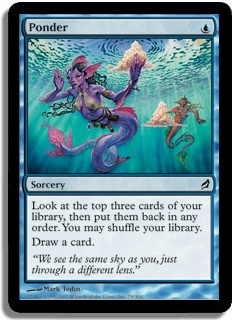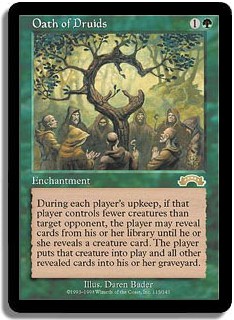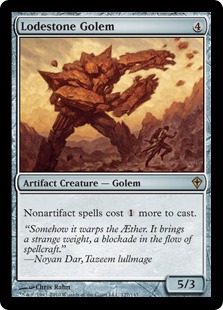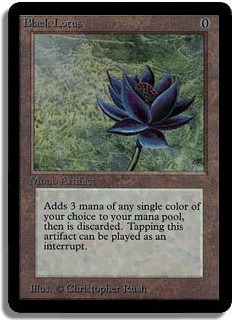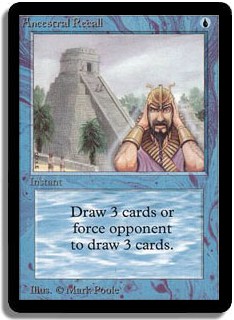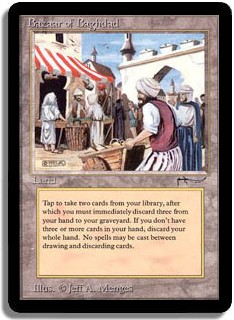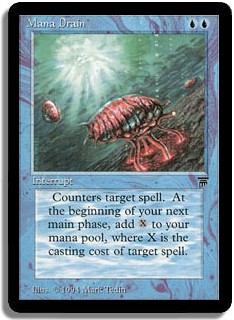For the third time in as many weeks, I am pleased to present another Vintage piece here on StarCityGames.com.
Last week I put out an open-ended request that people write in with questions, thoughts, and ideas about Vintage to be discussed, and I was not disappointed. I received a ton of feedback on a wide range of topics that I will cover here in today’s article.
Regrowth Unrestricted, Yay or Nay?
A change was recently made to Vintage’s banned and restricted list. Regrowth, a card that had been restricted to one copy since the beginning of the format, made its way off the list for the first time.
The biggest winner as a result of Regrowth coming off the list is likely Gush since once a player piloting that deck finds Fastbond and a copy of Gush, multiple copies of Regrowth functionally become Merchant Scrolls.
"Makeshift Merchant Scrolls."
Merchant Scroll is rightly restricted in Vintage in large part because of its abusive interaction with Gush. However, Regrowth is a significantly weaker card than Merchant Scroll because it lacks the early game flexibility to immediately find Ancestral Recall or Force of Will.
Regrowth also has some upside over Merchant Scroll. The most obvious is that it can recur Time Walk a bunch of times (presumably with a Jace, the Mind Sculptor in play) via Snapcaster Mage.
” Time Walk, Regrowth, Time Walk, Snapcaster Mage targeting Regrowth, Regrowth Time Walk.”
Time Walk is a super powerful spell, and in my theory of Magic it is the most powerful effect in the game. It doesn’t so much grant you an additional turn but rather denies your opponent an entire turn, which is quite abusive when done redundantly.
All of that being said, it is likely that the unrestriction of this restricted list mainstay is largely irrelevant—for now.
"Getting work done."
Mishra’s Workshop is the natural predator of Gush based strategies, and despite its slight decline in popularity over the past few months, it is still around to keep Gush in check. If dedicated Gush / Regrowth decks become a thing, Mishra’s Workshop will be there to bring them back down to Earth.
The other major strike against Regrowth is the amount of graveyard hate that already exists in Vintage. Dredge is a thing, and people already play with Nihil Spellbomb and Rest in Peace, both of which are cards that could make life very difficult for people trying to reuse Gushes.
Despite the hate, Regrowth has already been able to win a ten-man Next Level Vintage tournament.
Creatures (1)
Planeswalkers (2)
Lands (14)
Spells (43)
- 1 Brainstorm
- 1 Fastbond
- 2 Mana Drain
- 1 Vampiric Tutor
- 1 Mystical Tutor
- 1 Yawgmoth's Will
- 4 Duress
- 4 Force of Will
- 1 Sol Ring
- 4 Regrowth
- 1 Demonic Tutor
- 1 Hurkyl's Recall
- 1 Time Walk
- 1 Ancestral Recall
- 4 Gush
- 1 Gifts Ungiven
- 1 Merchant Scroll
- 1 Tinker
- 1 Black Lotus
- 1 Mox Emerald
- 1 Mox Jet
- 1 Mox Ruby
- 1 Mox Sapphire
- 1 Empty the Warrens
- 1 Ponder
- 3 Mental Misstep
- 2 Far
Sideboard

Disclaimer: The field only had two Workshop decks, which worked to the advantage of the Gush player. Four Regrowth Gush is an absolute golden gun against opposing blue decks.
Another deck that utilized the newly unrestricted Regrowth in a Gush shell appeared at the Player’s Council Open.
Creatures (2)
Lands (15)
Spells (42)
- 1 Tendrils of Agony
- 1 Brainstorm
- 1 Fastbond
- 3 Mana Drain
- 1 Vampiric Tutor
- 1 Mystical Tutor
- 1 Yawgmoth's Will
- 4 Force of Will
- 1 Sol Ring
- 2 Regrowth
- 1 Demonic Tutor
- 1 Hurkyl's Recall
- 1 Time Walk
- 1 Ancestral Recall
- 1 Mana Crypt
- 4 Gush
- 1 Gifts Ungiven
- 1 Merchant Scroll
- 1 Misdirection
- 1 Black Lotus
- 1 Lotus Petal
- 1 Mox Emerald
- 1 Mox Jet
- 1 Mox Sapphire
- 3 Repeal
- 1 Ponder
- 1 Nihil Spellbomb
- 3 Mental Misstep
- 1 Flusterstorm

The deck isn’t all-in on Regrowing Gush, but the two copies of Regrowth provide consistency, especially when trying to combo off.
While Gush may be the most obvious beneficiary of Regrowth’s unrestriction, the biggest winner may actually turn out to be Mishra’s Workshop. Gush Growth beats up on the blue "control" decks that have decent game against Workshops. If these decks are forced to adapt against Gush, it makes their matchup against Workshop worse. If these decks get pushed out of the metagame in favor of Gush, it makes Workshop much better.
We may actually be in a world where Lodestone Golem is the good guy who is now holding down the fort against Gush, which is primed to explode. I also worry that if Lodestone Golem ever becomes restricted that with Regrowth to fuel Gush decks that such a strategy actually has the ability to become dominant in the future.
Let’s take a look at what some fellow Vintage enthusiasts had to say about Regrowth’s recent unrestriction:
Personalbackfire:
"I fear that the unrestriction of Gush will make Gush Bond too good and result in a Gush restriction again. I liked the place that Gush had before the unrestriction as a potential deck but not overly powerful, though it seemed to be on the downswing for the last while. Time will tell if Gush Bond becomes the best blue deck, but I think it has the potential to be for sure. It is also interesting since there seems to be no feel for what a correct list looks like (I know it is still very early)."
I share your concern!
DubDub:
"I’m pleased that the restricted list is continuing to get shorter, and overall I think this represents more thoughtful management of the list. I am slightly worried that Regrowth and Ancestral / Time Walk will be unfun for some opponents who have basically no chance to interact, but I don’t think it will lead to dominance, nor do I think the amount of unfun will approach the levels seen when facing modern Prison or Dredge—Dredge in particular I view as basically orthogonal to ‘real’ decks (a statement that perhaps proves I’m biased)."
Interesting take on the situation from the perspective of how "unfun" it is to play against a broken deck. Is having to play against someone who "goes off" with Gush or Time Walk any more broken or obnoxious than playing against Dredge or Lodestone Golem?
Prospero:
"I’m glad that Regrowth came off the list, though I was surprised to see it happen. While I don’t think it’s a threat to the metagame, it’s a card that has lived on the B&R list since the list’s inception if I’m not mistaken. I think this may illustrate a shift in the DCI’s thinking, where they are now willing to consider things that had previously been unconscionable. This is a good thing."
Nick, I believe you are glad! Dear DCI, thank you for empowering an archetype that I will crush 100%. 🙂
All things considered, people seem to like this unrestriction but are unsure of exactly what is going to happen as time unfolds. Which, to be fair, is probably a good thing.
Personally, I do not like the latest move by the DCI. I do not favor the unrestriction of any card that makes any top tier deck more linear.
The Restricted List and Other Lists of Fail
One of the reasons that I don’t love the unrestriction of Regrowth is that I don’t believe it was the best move that could have been made with regard to the current restricted list.
I think that there are at least three and as many as five cards that would have been much safer to unrestrict than Regrowth. The three that come to mind are:
"Who’s afraid of the big bad wolf? Nobody."
Gifts Ungiven doesn’t even see play anymore and is basically a bad Jace, the Mind Sculptor. The format now includes cards like Spell Pierce, Flusterstorm, and Gush to keep Gifts in check.
Also, without Merchant Scroll, Brainstorm, and Ponder, Flash is a much less consistent and problematic deck to exist. In actuality, it would probably be good for Vintage to have Flash since it would be a deck that could throw Workshops for a loop.
Although I believe Flash to be a better unrestriction than Regrowth, I personally would not unrestrict it. One thing that I am always looking for with regard to Vintage is ways in which the quality of the games might be improved. I want more interaction, less blowouts, more different decks, and less one-sidedness. I don’t find that Hulk Flash creates particularly fun games of Magic, so I’d rather it not exist.
With that being said, unrestricting Flash does create a totally new deck (as opposed to Regrowth, which likely only improves an already good existing deck) that could actually be an attractive option to new potential Vintage players. I always err on the side of will this deck be fun to play with / or against? And while I don’t think it is a deck that would create an enjoyable tournament experience (at least for me), if it generates new interest in the format, I believe such a restriction at least has a purpose.
Yawgmoth’s Bargain is just a bad Griselbrand. Who cares?
"High risk, high reward."
In the same way that Regrowth is a risky unrestrict, so are these two cards. The issue is that at least these cards are interesting and exciting.
The extent of Regrowth’s life in the format is "how many do I play when I play Gush?" These cards encourage people to make decisions about how they build a wide variety of decks.
Balance would open up completely new archetypes.
Ultimately, I am in favor of the first four cards being unrestricted because they are comically worse than a dozen cards currently unrestricted in Vintage.
Interestingly enough, I am not in favor of Balance coming off the list even though it is one of my favorite cards of all time. While the card would certainly shake up Vintage in interesting ways, I believe it would be the nail in the coffin for creature-based decks.
It is my hope that attacking and blocking will one day be relevant in Vintage, and anything that hinders this and makes the format even more about spells I see as a negative. With that being said, Balance is not nearly as bad for creature decks as Oath of Druids…
The community had a lot to say about the list:
Twaun07:
"I would institute a six-to-eight month mandatory rotation policy of restriction or unrestriction to prevent format stagnation. Every six-to-eight months, cards would rotate on and off pending tourney performance. Plus, it might add more excitement in waiting for the B&R list announcements if you knew a card was coming off or going on."
I like when things get shaken up in Vintage because otherwise things mostly seem to stay the same. My only issue with this is:
"Need I say more?"
Shrewarmies:
"Nothing. I feel that Vintage is in a nice place right now. I would be watching the new Regrowth decks to see how they evolve over the coming months, but I would not be looking to make any changes in the near future."
While I haven’t always been pleased with the handling of the list, many others like Shrewarmies approve. It just goes to show that there are a lot of different perspectives.
Dubdub:
"I think I would unrestrict cards in this order provided at each step the metagame was healthy: 1. Balance 2. Library of Alexandria 3. Ponder 4. Gifts Ungiven 5. Flash 6. Thirst for Knowledge 7. Demonic Consultation 8. Yawgmoth’s Bargain."
Library is an interesting card because on the one hand I don’t think it would be too good but on the other I’m not sure it creates fun or interesting games of Magic. It is a card that crushes control mirrors, sure.
The other problem is that it probably triples the price of Library of Alexandria, which makes the format even more expensive to play. The idea of boarding $1500 worth of Library of Alexandria for the control mirror makes me cringe!
One of my biggest issues with the restricted list is that there are so many cards on it that are simply objectively much less powerful cards than cards currently unrestricted in Vintage.
While I tend to favor a stricter restricted list (would rather have more cards restricted), my main objection is in favor of consistency.
In my opinion:
Jace, the Mind Sculptor > Gifts Ungiven
Griselbrand > Yawgmoth’s Bargain
Bazaar of Baghdad > Library of Alexandria
My realistic view of what should probably be done with the restricted list moving forward:
Unrestrict
Restrict
Oath of Druids in Vintage is a lot like Survival of the Fittest in Legacy. It is a super cool card that is super powerful, and as long as it is just one of a bunch of powerful things it’s fine. The problem is that once new cards make it the most powerful thing with new printings it becomes obnoxious.
Oath of Druids was fine when people got Akroma, Angel of Wrath; Darksteel Colossus; Tidespout Tyrant; and Hellkite Tyrant, but Blightsteel Colossus; Emrakul, the Aeons Torn; and especially Griselbrand are too much. The new Oath targets are more than twice as powerful and end the game twice as quickly as before.
If I were the DCI and could do whatever I wanted with the list, I would really, really shake things up. My ideal Vintage format would look very different than the one that currently exists. I am of the mindset that there is a lot to be gained from burning it down and starting new. My primary concern, as it has been for years now, is creating a Vintage format where creature-based decks are a real, viable strategy.
I would restrict Lodestone Golem; Jace, the Mind Sculptor; Oath of Druids; Mana Drain; Bazaar of Baghdad; Gush; Dark Confidant; and Standstill.
Also, I would ban Time Vault.
The reason I would make this move is that the Vintage testing I have done for my Vintage article series coupled with my tournament experiences from the past three years leads me to believe that one major fact tends to be true of Vintage:
The best strategy in Vintage is to get ahead on the first turn and leverage that advantage to stay ahead—you will win at a very high clip.
Every deck in Vintage utilizes at least one set of an unrestricted card that can be consistently cast on the first turn on the play that just levels the opponent.
Lodestone Golem, Standstill, Oath of Druids, Bazaar of Baghdad, and Dark Confidant are the cards I see as best at leveraging the play. I have also famously objected to Bazaar of Baghdad as an "on principle matter" for a long time, and nothing since has swayed my opinion on that card. Bazaar of Baghdad is a card that I am not sure of—it is possible that Dredge in its current iteration could stay and be public enemy #1—but I can also see positives to knocking it down a notch along with everybody else.
In the wake of taking away the cards that so heavily leverage the coin flip, I would anticipate Mana Drain; Gush; and Jace, the Mind Sculptor to be the best cards and would preemptively nip that in the bud.
The effect I would try to achieve via a wide range of restrictions would be to take the emphasis off of the advantage gained by winning the coin flip and create a state of game play that is more interactive with more battling back and forth for position. I would also seek to create a metagame where playing and attacking with creatures is a more viable strategy.
Players are wary of change, and this would simply be too much change too fast. The reason this will never happen is because it is a far too risky an endeavor to ever implement.
However, one thing to keep in mind is that if Lodestone Golem ever finds itself restricted (and I believe it is only a matter of time until it does), Vintage is going to crumble like a house of broken unrestricted cards.
Notice that the list of cards I would restrict is actually Lodestone Golem and six blue cards. If Lodestone Golem is removed from the equation, blue decks completely take over the format, and there is nothing to hold them back. In actuality, currently Lodestone Golem and Mishra’s Workshop are the only things that are holding Mana Drain back from being the only tier I option in Vintage.
Don’t get me wrong here—I actively and openly dislike the emphasis that Lodestone Golem puts on winning a coin flip and find the effect it creates with regard to in game play to be extremely undesirable. I wrote multiple matchup analysis / strategy articles for match p X vs. MUD and have grown increasingly disdainful of offering my readers the insight of:
If you win the die roll, you are 75% to win, and if the enemy wins the die roll, they are 75% to win, soooooo win the roll. Overall, the matchup is about 50-50.
I am also sympathetic to Workshop players who rightly acknowledge that Lodestone Golem on the play is the contributing factor that gives them a 50% matchup against Mana Drains and that without Lodestone Golem to anchor their strategy blue would be undeniably the best strategy in the format.
Ultimately, I am a tournament player, and I want to play games of Magic that are fun, interesting, and interactive. The hopelessly miserable experience that is losing to Lodestone Golem on the draw is a major negative to have associated with Vintage. Trinisphere has set the precedent for miserable games created by Workshop on the play are bad for Vintage, bad for players, and bad for Magic and thus subject to DCI intervention.
It is my thought that it is only a matter of time. Keep in mind that every time Workshop gets a playable card to make it better that Lodestone Golem moves closer to the edge of restriction, and when Lodestone goes I believe many, many of blue’s toys will also be called into question.
One thing I have always taken offense to is that by stating my thoughts I open myself to a lot of criticism by individuals who share a preference for a different kind of game than I do. I recognize that there are a lot of people who have different ideas about what constitutes a fun Magic tournament experience from what I or anyone else might like.
I have been called everything from a whiner to a Vintage traitor, and it does sting a little bit. It has always been my goal to use my position as a Vintage writer to promote, popularize, and serve the Vintage format to the best of my ability.
I love the Vintage format and always have, and that is why I continue to write about it, test it, learn about it, think about it, try to run tournaments for it when I can, play it casually with friends (despite having no tournament support in my area), etc. It also frustrates me that in my opinion the format is only a fraction of what it could be had things been handled differently in the past.
I think that almost every decision that has been made with how to run, promote, and foster Vintage as a format has been fumbled, mismanaged, or done poorly, which is all but a nail in the coffin for a format that already has everything going against it. The upholding of the reserved list, bizarre restrictions/unrestrictions, backward and personally motivated execution of the restricted list, bare minimal support of Vintage events, poor to non-existent event coverage, the fact that Power is the absolute last thing to be released on Magic Online—the list goes on and on.
It is my thought that creating a format more likely to attract new players (especially with the eminent release of Power online) is the best way to create interest in the format. Fostering a format that creates new and familiar options like viable creature decks is a sexy proposition for potential new players. I also think that as Legacy continues down its logical, inevitable path of decline (as a result of rising prices and the reserved list) there is a real opportunity to port Eternal players from Legacy into Vintage.
I am not saying that everybody will quit playing Legacy and switch to Vintage, but I think that given the right moves there is a possibility to have a larger portion of players who participate in both formats. People who can afford to spend thousands of dollars on Legacy cards are likely capable of affording the next step up and also playing Vintage.
The kind of games Lodestone Golem leads to are not a strong incentive that would lead to players to want to play Vintage (in my opinion), which is why I think that while he does a good job of keeping blue decks in check that ultimately he is a net negative to exist in Vintage.
The printing of the Power Nine on Magic Online is the absolute last opportunity for Vintage to make a push at being something bigger, more popular, and more played than it is right now. It is a moment that as a fan of the format I absolutely do not want to see wasted like so many other missed opportunities.
For the record, Mana Drain is the enemy and always has been the enemy, but I will get to that later.
The Best Vintage
I put out the question, "What is the best Vintage era of all time?" and was curious as to how people would respond to it.
I got a ton of responses, and the most popular two responses with four and three votes were the Gifts era and the second Gush era.
Interestingly enough, not a single person voted for the current era.
The era that won also had the added bonus of the SCG circuit, which created a lot of big tournaments and a really dynamic metagame.
Another interesting fact is that very few people voted for any Vintage era after the errata to Time Vault.
"Nobody loves you."
I also asked, "What are people’s favorite decks of all time?" and got a lot of interesting responses.
Various combo decks were the overwhelming favorite, especially decks that played Tendrils of Agony. More than half of the responses favored different Storm decks.
Once again, no Time Vault decks…
For the record, my favorite Vintage deck of all time:
Creatures (7)
Lands (16)
Spells (37)
- 4 Brainstorm
- 4 Mana Drain
- 1 Vampiric Tutor
- 1 Mystical Tutor
- 1 Yawgmoth's Will
- 4 Force of Will
- 1 Mana Vault
- 1 Sol Ring
- 1 Demonic Tutor
- 1 Time Walk
- 1 Ancestral Recall
- 1 Imperial Seal
- 1 Mana Crypt
- 1 Gifts Ungiven
- 1 Burning Wish
- 4 Thirst for Knowledge
- 1 Mindslaver
- 1 Echoing Truth
- 1 Tinker
- 1 Black Lotus
- 1 Mox Emerald
- 1 Mox Jet
- 1 Mox Pearl
- 1 Mox Ruby
- 1 Mox Sapphire

Four Brainstorm and four Thirst For Knowledge—I can’t even believe this was real!
Maybe the real elephant in the room is whether Time Vault makes the format much worse by existing…
The two constants that appear to be true for the decks and eras that players seem to like are periods where Vintage as a format thrives (there are a lot of players and events) and where the decks are very powerful but the format is very interactive.
Another thing I notice about the time periods that appear to be the most popular is that these periods include multiple pillars of decks yet there is less of a linear rock, paper, scissors effect going on. Drains beat Stax, Stax beat TPS, and TPS beat Drains—or did they?
Certain decks were favored, but any deck had a real fighting chance in any given matchup—even against Workshop decks the die roll was not a death sentence. Tournaments during these eras consistently attracted upwards of 100 players who were excited to play Vintage, and players who didn’t play Vintage wanted to play Vintage because the games were so interesting and featured so many decisions and cool plays.
Vintage Battle Campaign
"The coolest cards ever printed."
One of the most appealing aspects of Vintage is that a player gets to cast the most awesomely cool cards ever printed.
As I have already made quite clear, my favorite Vintage (and many others as well) had longer and more strategic games than can currently be found. That is no knock on current Vintage—it is sweet and super interesting—but it isn’t my favorite version of Vintage ever manufactured.
How come there is only one recognized format where we can play with Black Lotus? Vintage is the only recognized format (sanctioned) where I can cast my uber cool old cards.
Highlander Vintage would be pretty sweet and would create a much different style of game than can currently be found. However, that didn’t even go far enough to satisfy my love of infinitely complex and complicated formats.
So I invented my own.
Introducing Vintage Campaign Battle!
The rules of this format are quite simple.
1. Vintage banned list, every nonbasic land card is restricted.
2. 100-card minimum deck.
3. No sideboard.
4. Best of three series.
5. If a spell or ability an opponent controls would put a card from your library into your graveyard or exile zone, you may choose to ignore that effect.
6. At the end of each game, each player exiles their hand, graveyard, and cards in play and does not shuffle them back into their deck for the remaining games.
7. Cards that are exiled from previous games count as being in your sideboard during games, so you can Wish for them.
This format is insanely fun to play.
The interesting thing is that your deck basically needs to have three different ways to win three separate games. So you can Key + Vault somebody, but only one time out of five games.
Also, for those who are really ambitious, best out of five with 150-card decks…
Here is the first deck I have built for this format:
Creatures (11)
- 1 Solemn Simulacrum
- 1 Sundering Titan
- 1 Trinket Mage
- 1 Dark Confidant
- 1 Mulldrifter
- 1 Vendilion Clique
- 1 Stoneforge Mystic
- 1 Sun Titan
- 1 Phantasmal Image
- 1 Snapcaster Mage
- 1 Notion Thief
Planeswalkers (3)
Lands (39)
- 1 Strip Mine
- 2 Plains
- 1 Wasteland
- 1 Volrath's Stronghold
- 1 City of Brass
- 1 Mishra's Factory
- 1 Swamp
- 4 Island
- 1 Underground Sea
- 1 Tundra
- 1 Scrubland
- 1 Polluted Delta
- 1 Flooded Strand
- 1 Faerie Conclave
- 1 Vault of Whispers
- 1 Seat of the Synod
- 1 Ancient Den
- 1 Riptide Laboratory
- 1 Tolarian Academy
- 1 Dimir Aqueduct
- 1 Watery Grave
- 1 Godless Shrine
- 1 Orzhov Basilica
- 1 Azorius Chancery
- 1 Hallowed Fountain
- 1 Academy Ruins
- 1 Urborg, Tomb of Yawgmoth
- 1 Mystic Gate
- 1 Sunken Ruins
- 1 Arcane Sanctum
- 1 Drowned Catacomb
- 1 Glacial Fortress
- 1 Bojuka Bog
- 1 Celestial Colonnade
- 1 Creeping Tar Pit
Spells (45)
- 1 Sensei's Divining Top
- 1 Brainstorm
- 1 Mana Drain
- 1 Counterspell
- 1 Vampiric Tutor
- 1 Mystical Tutor
- 1 Enlightened Tutor
- 1 Yawgmoth's Will
- 1 Force of Will
- 1 Scroll Rack
- 1 Swords to Plowshares
- 1 Mana Vault
- 1 Control Magic
- 1 Balance
- 1 Sol Ring
- 1 Demonic Tutor
- 1 Time Walk
- 1 Ancestral Recall
- 1 Mana Crypt
- 1 Time Vault
- 1 Gifts Ungiven
- 1 Cunning Wish
- 1 Crucible of Worlds
- 1 Skullclamp
- 1 Thirst for Knowledge
- 1 Tinker
- 1 Voltaic Key
- 1 Black Lotus
- 1 Vindicate
- 1 Fact or Fiction
- 1 Mox Emerald
- 1 Mox Pearl
- 1 Mox Ruby
- 1 Mox Sapphire
- 1 Engineered Explosives
- 1 Mystical Teachings
- 1 Cryptic Command
- 1 Path to Exile
- 1 Nihil Spellbomb
- 1 Sword of Feast and Famine
- 1 Black Sun's Zenith
- 1 Batterskull
- 1 Dismember
- 1 Lingering Souls
- 1 Supreme Verdict

I have only actually gotten to play one time so far, and it was really fun. I lost 1-3 to an aggressive RWUG deck that ran me over. (Green Sun’s Zenith is really good in this format by the way).
When I designed this Vintage variant, I approached it from the perspective that I wanted a format that allowed players to play with the most powerful cards ever printed but also promoted an emphasis on flexibility and strategy. Basically, a player can do whatever they want and any powerful play in Vintage is acceptable in here, but one’s deck must also be able to do other things as well.
Another thing that is kind of cool about the format is that there is a benefit to conceding a game strategically. For instance, if my opponent has the game wrapped up and then casts Brainstorm or some other way of putting cards back in their library, a player can concede to stop somebody from restocking.
Vintage Highlander is also an option as another way to play with the old cards, as are the various "old Type I" formats that have begun to grow in popularity lately.
For instance, a group of guys that I know have started getting into a format called The Dark Back where players use the restricted list and card pool that was available back in 1995.
There are so many cards available to deckbuilders in Vintage, and it is kind of strange to me that there is only one set of rules that people agree to play by (i.e., the current Vintage restricted list).
In my view, one way to expand the popularity and playability of Vintage is to have other Eternal formats that include cards like the Power Nine, Workshop, Bazaar, etc. as alternatives for tournament and casual play. The reason I think this to be the case is that if people had other reasons to own the cards besides just to play one niche format, they would be more invested in owning and thus playing them.
It is my view that the popularity of the Commander format is one of many reasons that Legacy has surged and replaced Vintage as the format of choice. Obviously, the SCG Legacy Open Series replacing the SCG Vintage Power 9 series is a huge reason also, but nonetheless the more reasons that players have to own Vintage cards, the more likely they are to want to play Vintage.
I also look at Vintage Highlander, Vintage Battle Campaign, and The Dark Back as tournament formats that could become very popular if the complete Vintage card pool were ever to see play online, much in the same way that 1v1 Commander would be a very popular format were it ever offered on Magic Online.
I have really enjoyed playing this format so far and hope that some of the Vintage fans out here will take this format for a test drive. I am pretty sure that my Esper deck actually sucks, so I wouldn’t use it as a starting point.
Also, since I haven’t gotten to play a ton of it so far, there is a lot of wiggle room with the rules. Perhaps milling isn’t too good? If anybody ends up jamming games with friends, I would be very interested to get feedback and insights.
Why Do People Hate on Non-Blue Decks?
TheManaDrain.com is down so I can’t directly quote the question that I was asked, but the gist of the question was "why do people always overreact to non-blue decks when they are good?"
A fair question.
"I assume you mean these guys?"
I think there is a simple answer and then a deceptively complex answer to this question.
The simple answer is that Bazaar of Baghdad and Mishra’s Workshop decks are extremely unsatisfying to lose to. Mulliganing to four looking for a Leyline and not getting it or getting "LODESTONED" on the play in the two games where the MUD player is on the play are among the most frustrating experiences in all of tournament Magic.
These types of losses cause players to feel like they didn’t get to "play" Magic and that their decisions (or lack thereof) really had zero impact upon the outcome of their match.
Vintage is full of broken cards and plays, and it is certainly not unreasonable to get blown out by powerful hands twice in a match. For instance, is there a difference between getting Lodestone Golemed and getting Dark Ritual into Necropotenced on the first turn? Or turn 1 Jace, the Mind Sculptored?
Functionally, not really. All of these plays are much more often than not a death sentence.
The difference, in my view, is that with Bazaar of Baghdad and Lodestone Golem that because the decks consistently produce the same old redundant win the game conditions that people actually start to get sick of it in a hurry.
Decks have a much more difficult time producing turn 1 Jace, the Mind Sculptor or Necropotence because it is harder for blue decks to crack four mana (than Workshops) and because decks only get to play one copy of Necropotence and don’t always have it and the necessary BBB to put it in play.
Often, when non-blue decks are tier 1, they make it abundantly clear that they are stomping your face into the dirt because of the manner in which they win. The games feel out of control and feel miserable against MUD or Dredge, whereas against blue decks players often are deceived into feeling like they are in the game when perhaps they are not as "in it" as they think.
A good blue deck might have every move a player tries to make negated at every step with the ability to win on turn 3 or 4, but the opponent (because they can’t see the blue mage’s hand) doesn’t necessarily know how behind they actually are. Also, because blue decks use their life total as a resource, players can attack them, make some plays, etc. before getting Time Vaulted, Gushed, etc., which creates the illusion that they were inches, a card, or a turn away from winning.
With Lodestone Golem MUD and Bazaar there are no illusions or deceptions about what is going on: you were never in the game, you are not in the game, and there will be no opportunity for you to ever be in the game.
Blue decks are always very good and it is unusual that they are ever not the best decks in Vintage, but it is always under the guise that they are good but not broken. The only time that blue cards get restricted in Vintage is when literally nothing else can win. Blue decks don’t turn 1 people all that often, but they let us know when things have reached the point of absurdity in moments where other decks simply stop being able to compete—for example, the Gush era, the Gifts era, the Thirst for Knowledge era, and so on.
MUD, featuring the powerful Lodestone Golem, in some configuration may very well be the most consistent, powerful, and best deck in Vintage at the moment. Yet while it may be the best deck generally speaking,it certainly isn’t the best deck against a tier 1 blue deck if it loses the coin flip or is on the draw in Top 8. If you need further proof of this fact, just ask 2012 Vintage World Champion Mark Lanigra, who won the Swiss and dispatched multiple Workshop players from Top 8 (largely predicated by having a well-tuned list but also having the play).
It is also my opinion that the majority of Vintage players are largely biased toward playing and arguing in favor of the decks they like the most. Most players are not objective and approach discussions about the restricted list from the perspective of wanting to restrict the cards that beat the deck they want to play. If this is true—and it is—blue decks have always been the best decks, and it stands to reason that the most players by percentage have had success playing blue decks and want to continue being successful playing their favorite blue decks.
I am also certainly biased in my opinions for wanting certain cards restricted, but I try to be careful to not have my preference for what I like to play affect my argument.
My bias is to restrict cards in such a manner as to achieve the following outcome.
1. Alleviate the emphasis away from the importance of being on the play.
2. Open up space for creature combat to exist and thrive in Vintage.
3. Open up space for games to have more back and forth play with fewer blowout games.
4. Create a format that is more attractive for potential new players to want to play.
Also, please don’t misunderstand me. Just because I want creature decks to be better doesn’t mean it is because I want to play them.
I will be the guy casting Yawgmoth’s Will out of the singleton combo control deck…
The point isn’t that any one deck is too good (maybe Mana Drain secretly is?) but that there are multiple decks that are all too good for their own good. The question then becomes why does it matter if everything is too good since aren’t all the too good decks essentially equal? And do we not also have a reasonably large diversity of decks on a similar power level?
It matters because if all of the best decks all blow people out, it creates an unfair advantage for the deck that is on the play, making the die roll play an unreasonably important role in deciding matches. Keep in mind that being on the play or getting the card on the draw are supposed to be equal propositions in Magic (even though one of these equal halves is obviously more equal in Constructed). In Vintage, the inequality of being on the play is perhaps more pronounced than in any other format because of the amount of advantage decks are able to take off the tempo. Lodestone Golem anyone?
The last part of the equation and the down and dirty truth of the matter.
As I began earlier: Mana Drain is the enemy and always has been the enemy…
"The inconspicuous obvious overlord of Vintage."
There is a secret code in Vintage that everybody knows, which is that Mana Drain always needs to end up being the best and always does end up being the best. The Vintage community desires for, roots for, and does everything in its power to ensure that Mana Drain is the best card and best deck in Magic.
Whenever Mana Drain isn’t the best deck, it is because something else is degenerate, broken, or too good. If Mana Drain decks can’t find a way to beat the other for an extended period of time, then begins the talk of restricting the threat. The joke is, of course, that if anything is actually better than Mana Drain, it probably does deserve restriction because in actuality Mana Drain is and always has been too good!
So the DCI restricts the Flashes, Trinispheres, Lion’s Eye Diamonds, and Gushes of the world to make the world safe for Mana Drainers once again, and when Mana Drain decks are unbeatable, they blame the flavor of the week card draw—Brainstorm, Gifts, or Thirst for Knowledge—so that Mana Drain decks are not so good that they win every tournament but are good enough to win a lot of them.
The biggest mistake in my estimation is that the world is always made safe for the pillars rather than anybody ever questioning the pillars themselves. Nothing can ever be better than the best Mana Drain decks, and the Mana Drain decks can never be too much better than everything else. And, by everything else, I of course do not actually mean everything else but only mean Mishra’s Workshop decks, Bazaar of Baghdad decks, and Storm decks.
If some meta creature deck is viable for a minute, "hey bonus," but in general if it isn’t one of these pillars, it really doesn’t matter whether it lives or dies in the long term.
Vintage: Then, Now, Always
Vintage is my favorite format because every time I play it I get to go back in time and cast all of the coolest spells ever printed the same as I did when I was twelve years old and discovering Type I for the first time. It is a format that is important because it is the one link that ties all of Magic, past to present, together.
I will play Vintage for as long as I play Magic regardless of whether I think the banned and restricted list is perfect or far from it because to play Vintage is to participate in the history and progression of a chain of events that started nearly twenty years ago and will continue on until the game of Magic ends. Vintage is the essence and the entirety of Magic: The Gathering because it has existed since the beginning and encompasses every card ever printed and every card that will ever be printed.
What the format represents is bigger than any single card, any single pillar, or any single strategy because what it represents is an opportunity for people who love Magic to play anything and everything that they want to play. Vintage should not exist merely as a space for people to play four of the same cards they always did; I believe those cards exist to enrich the experience of playing a format that highlights the tradition of the greatest game in the world.
The thing that I deem most precious and valuable about Vintage is the tradition and the opportunity to leave a legacy upon something with a storied history and an ongoing future. Vintage gives players the opportunity to participate in the evolution of an ongoing process and to participate in a game that started twenty years ago and continues on indefinitely.
I would rather participate in the writing of a narrative that is dynamic, wrought with innovation, and hard fought back and forth battles than one that moves down a path of crowning champions of die rolls and coin flips.
The last time I played in a Vintage tournament without Mana Drain in my deck was almost eight years ago (Trinistax), and I would surrender my Mana Drains to make Vintage a better format.
Who is the real Vintage traitor?
Cheers,
Brian DeMars

